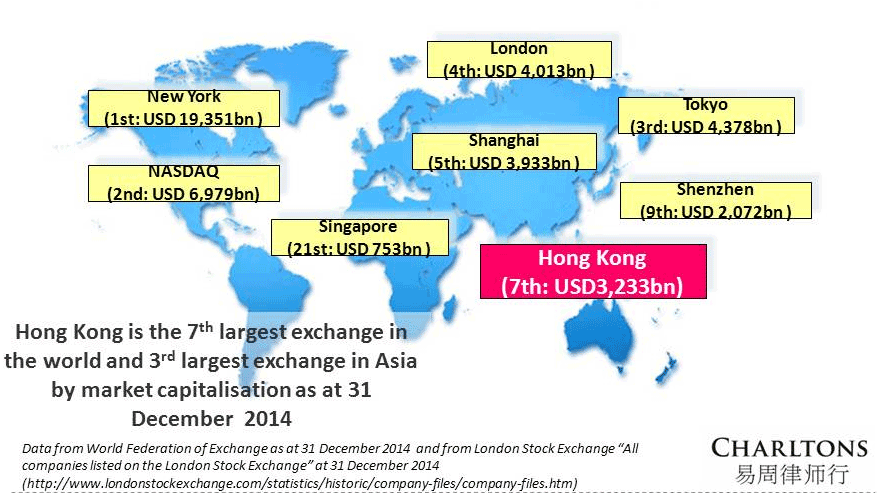IPOs
Stock Exchange Rankings
By Market Capitalisation

- Hong Kong Stock Exchange (HKEx) is the world’s 7th largest stock exchange
- 3rd largest in Asia after Japan and Shanghai
- market capitalisation of HK$ 25,071.8 billion (US$ 3,233 billion at end 2014)
- Shanghai Stock Exchange (SSE) ranked 5th
- market capitalisation of US$ 3,933 billion
- Shenzhen Stock Exchange (SZSE) ranked 9th
- market capitalisation of US$ 2,072 billion
Source: Data from World Federation of Exchanges as at 31 December 2014
By IPO Fund Raising
- Hong Kong ranked 3rd (after NYSE and LSE Group) in 2014
- HKEx raised US$ 29.3 billion (up 33% on the US$ 21.8 billion raised in 2013)
Number of IPOs
- Hong Kong ranked 3rd in 2014
- 115 new listings (excluding transfers from Growth Enterprise Market to Main Board)
- Hong Kong ranked in the world’s top five IPO exchanges and as top Asian exchange for IPOs for the past 13 years
Source: Data from HKEx Market Statistics 2014 & 2013
PRC Exchanges
- The China Securities and Regulatory Commission (CSRC) controls both the flow of listings and IPO pricings on SSE and SZSE
- SSE and SZSE were closed for IPOs from Nov 2012 to Jan 2014
- The exchanges were reopened in 2014 for 7 months
- SSE raised US$ 5.2 billion in 39 IPOs
- SZSE raised US$5.8 billion in 76 IPOsErnst & Young 2014 Q4 Global IPO Trends
- In Q4 2014, most China IPOs rose the maximum 44% allowed on 1st day of trading
- In 2010-2013, Shanghai Composite index (SCI) was among the world’s worst performing stock markets
- In 2014, SCI became the world’s best performing major stock market
- rose almost 53%
- broke 3,000 points in early December for 1st time since 2011
- The rally in equities occurred mainly in Q4 2014 due to number of factors
- People’s Bank of China announced decision to cut interest rates in November 2014 for 1st time in 2 years
- Government-led structural reform
- Implementation of Shanghai-Hong Kong Stock Connect which opened Shanghai’s A-share market to foreign investors for the first time
- Rally in Mainland-listed A shares fuelled by China’s retail investors who account for some 80% of trading
- Record numbers of securities trading accounts were opened in 2014 – one week in November 2014 saw 370,000 new trading accounts opened
- China’s IPO market is expected to be robust in 2015
- 200 new listings expected on the Mainland exchanges, raising about RMB 130 billion (US$20.9 billion) in 2015
Price Waterhouse Coopers 2014 Market Review
CSRC Policies
- IPO reform is key priority for CSRC
- CSRC has announced plans to replace the existing application-and-approval system with a registration mechanism
- Listing applicants will be required to disclose information about earnings and operations
- Pricing of IPO shares will be determined by the market
- If implemented, the proposed market-based IPO regime is expected to give a further boost to the A share market
- SSE and SZSE do not yet allow foreign companies to list
- Huge back-log of Chinese companies waiting for approval to list on SSE and SZSE
Hong Kong Stock Exchange
- HKEx is international listing venue of choice for Mainland Chinese companies due to:
- faster listing process
- access to international capital
- HKEx ended 2014 on a high note with IPO pricing improving in 4th quarter
- 44% of Q4 IPOs priced at upper end of indicative range (up from 35% in Q3)
Optimistic forecast for HKEx in 2015
- PwC predicts HKEx will be in world’s top 3 exchanges for IPOs in 2015
- 120 new listings expected to raise HK$200 billion (US$25.8 billion)
- Bulk of new listings to be small- and medium-sized enterprises
- Retail, consumer goods and financial services expected to dominate(Price Waterhouse Coopers 2014 Market Review)
- Attractiveness of HK listing enhanced by HK deep liquidity
- Facilitates post-listing fund raising by HK-listed companies
- In 2014, listed companies raised HK$708 billion (US$91 billion) in follow-on offerings
Link with Mainland China
Hong Kong Stock Exchange: Chinese Company Listings
- Hong Kong has long been the preferred international listing venue for Mainland Chinese companies looking for access to funds in the international capital markets
- 822 Chinese companies listed on the HKEx (56% of total market capitalisation)
- In 2014, 4 out of the top 5 companies by IPO funds raised in Hong Kong were Mainland Chinese companies
Top 5 Companies listed on HKEx by IPO fund raised in 2014
| Stock Code | Company Name | Country | Market Capitalisation (US$ mln) | Fund Raised (US$ mln) |
| 3699 | Dalian Wanda Commercial Properties Co., Ltd | PRC | 3,808 | 3,692 |
| 1816 | CGN Power Co., Ltd | PRC | 4,823 | 3,617 |
| 2638 | 38 HK Electric Investments and HK Electric Investments Ltd. | HK | 5,800 | 3,093 |
| 288 | WH Group Ltd | PRC | 8,338 | 2,347 |
| 1958 | 8 BAIC Motor Corporation Ltd | PRC | 2,308 | 1,414 |
Link with Mainland China
Hong Kong Stock Exchange
- HKEx = leading international stock market
- Allows full access to overseas investors and provides a listing venue for overseas companies that meet its listing requirements
- Offers overseas companies access to Chinese capital
- HKEx positioning itself as gateway for Mainland Chinese to invest internationally
- First step – Launch of Shanghai-Hong Kong Stock Connect on 17 Nov 2014
Shanghai-HK Stock Connect
- Shanghai-Hong Kong Stock Connect enables:
- Hong Kong and international investors to buy Shanghai-listed stocks
- Northbound trading link (from HK to PRC) allows trading in constituent stocks of the SSE 180 and SSE 380 Indexes
- Mainland professional investors to buy Hong Kong-listed stocks
- Southbound link (from PRC to HK) permits trading in the constituent stocks of HKEx’s Hang Seng Composite LargeCap and MidCap Indexes
(“professional investor” = someone with RMB 500,000 in cash/securities)
- Hong Kong and international investors to buy Shanghai-listed stocks
- Trading in companies with dual listings on the Shanghai and Hong Kong stock exchanges is also allowed through the link
- Only secondary market trading is allowed under the programme so investors cannot yet subscribe in IPOs on either market
- Northbound trading and Southbound trading are subject to separate aggregate and daily quotas
- Hong Kong and international investors can trade up to RMB 13 billion (HK$16.4 billion) a day in Shanghai-listed A shares
- Mainland investors can trade up to RMB 10.5 billion a day in Hong Kong stocks
Shanghai – HongKong Stock Connect(17 November – 31 December 2014)
| Northbound Trading | Southbound Trading | |
| Total trade value | RMB 167,512 mil | HK$ 26,011 mil |
| – Buy | RMB 118,041 mil | HK$ 19,580 mil |
| – Sell | RMB 49,471 mil | HK$ 6431 mil |
| Average daily turnover | RMB 5,584 mil | HK$ 929 mil |
| Aggregate quota usage | RMB 74,632 mil* (25% used) | RMB 10,500 mil^ (4.2% used) |
| * 31 December 2014 (the last trading day of Northbound trading in 2014) ^ 24 December 2014 (the last trading day of Southbound trading in 2014) |
||
- Originally expected that HKEx’s lower valuations of companies dual-listed in Shanghai and HK would see Chinese investors rush to buy HK-listed Mainland companies (i.e. H shares)
- However, net Northbound purchases of Shanghai-listed shares have significantly exceeded net Southbound purchases
- International investors bought a net RMB 68 billion of Shanghai shares since the link’s Nov. 17 debut, out of a limit of RMB 300 billion
- Mainland investors purchased a net RMB 13.1 billion of Hong Kong-listed shares out of aggregate quota of RMB 250 billion
- Expected that Northbound trade will increase as more overseas funds obtain regulatory approvals to invest in A shares
- Importance of Shanghai-Hong Kong Stock Connect:
- It represents a major step in the opening of China’s capital markets to foreign investors
- It helps further the internationalisation of the RMB
- Access to Chinese capital increases the attractiveness of HKEx
- The Exchange has stated that:
- the programme is scalable in size, scope and market in the future
- cross-border capital raising may eventually be permitted under the programme, subject to SFC and CSRC regulatory approvals
- Requirement for Mainland investors to be “professional investors” is expected to be relaxed
- If current restriction on shares’ eligibility for trading under Southbound link is relaxed, this will be very attractive to overseas companies
New Developments
Hong Kong and international investors will soon be allowed to conduct covered short-selling of A-shares under the Northbound link
- HKEx carried out a system test for the short-selling service over the weekend of 10 and 11 January 2015, and aims to allow short selling in Q1 2015
Hong Kong Stock Exchange’s update on 6 January 2015
- In March, HKEx plans to implement a new system so that institutional investors who hold A shares through custodians will no longer need to transfer their A shares to brokers the day before they want to sell in order to comply with China’s pre-trade checking requirement
- Many overseas fund managers are currently prevented from trading A shares through the Northbound link as their rules prevent compliance with this requirement
- The requirement is contrary to standard international practice which allows settlement within 2 days after sale which is followed in Hong Kong and other leading markets
Shenzhen-Hong Kong Stock Connect
- A stock connect between Shenzhen and Hong Kong may also be implemented in the near future
- SZSE announced that Shenzhen and Hong Kong will seek regulatory approvals once their plans are “mature”
- A trading link with SZSE would allow foreign investors access to some of China’s most dynamic private companies in the technology and health-care industries
Mutual Recognition of Funds Scheme
- A scheme providing for the mutual recognition of funds authorised in Hong Kong and the Mainland is in its final stages
- The MRF scheme is expected to allow Hong Kong-domiciled funds authorised by the SFC to be sold in the Mainland, while Mainland funds authorised by the CSRC will be allowed to be sold in Hong Kong
- First scheme providing for mutual recognition of funds between the Mainland and a foreign market
- Consistent with the goals of developing Hong Kong as an offshore RMB centre and an international asset management centre set out in China’s 12th Five-Year Plan
Speech given by Alexa Lam, deputy chief executive officer of Hong Kong’s Securities and Futures Commission (SFC), at a conference in October 2014
Weighted Voting Rights
Issue – whether listings should continue to be restricted to companies with “one share one vote” (OSOV) structure, a rule in place since 1989
- Top IPO exchange in 2014 was NYSE, for the 3rd year in a row
- raised US$66.4 billion
- driven by the world’s largest IPO ever, of Chinese internet company, Alibaba Group, which raised US$25 billion in September 2014
- Alibaba’s first choice listing venue was Hong Kong, but Alibaba’s governance structure would have contravened the Exchange’s OSOV principle
- a group of Alibaba’s founders and senior management members are given the exclusive right to nominate a simple majority of its board members despite a single class of ordinary shares with OSOV
Concept Paper
HKEx published a Weighted Voting Rights Concept Paper for consultation in August 2014
- whether Hong Kong should change its Listing Rules to accommodate companies with dual share and other weighted voting rights structures
Arguments
- +ve:
- Allow Hong Kong to recover its competitive position as the international fund raising market of choice for Mainland Chinese companies, given the recent popularity of the NYSE and NASDAQ for listing Chinese tech stocks
- WVR structures are particularly common among tech companies. The OSOV principle effectively prevents Hong Kong listing of many Chinese tech companies (e.g. Alibaba, Baidu, JD.com Inc. and Weibo Corp) which list in the US where WVR structures are not an obstacle to listing
- -ve:
- Investor protection concerns (allayed to a degree by Hong Kong’s already comprehensive regulation of connected and related party transactions and the provisions of the Takeovers Code requiring equal treatment of shareholders in takeover situations)
Consultation period ended in November 2014 and conclusions are expected soon
Key attractions for overseas companies
- Key advantages of Hong Kong as a listing venue
- established legal system based on English common law
- regulatory framework on a par with other international finance centres
- tax advantages, currency convertibility, free transferability of securities and no restrictions on capital flow
- abundancy of international investment banks, law firms and accountancy firms facilitates company listings
- opportunity to raise corporate profile and visibility in China and the rest of the Asia-Pacific
- 1,752 companies were listed on HKEx at the end of December 2014
- 1,548 were listed on the Exchange’s Main Board
- A key attraction of the Hong Kong market is the depth of liquidity in both its primary and secondary markets
- 122 new listings on HKEx (including transfers from the Main Board to GEM) raised US$29.3 billion in 2014 (an increase of 35% compared to 2013)
- Hong Kong is a popular listing venue for luxury goods sector companies (e.g. Coach, L’Occitane and Samsonite) looking to raise profile in Asia
- In 2011, Prada raised US$ 2.14 billion by listing 20% of its share capital on HKEx
- China’s position as a major consumer of energy, minerals and metals has also attracted a number of mining and natural resource companies to list in Hong Kong
- Energy companies listed in Hong Kong include: Swiss commodities giant Glencore International AG, Russia-based United Company Rusal PLC, Kazakhstan copper miner Kazakhmys PLC and Brazilian metals and mining company Vale S.A.
- Vale S.A was also the first company to list on the Exchange in the form of depositary receipts (HDRs).
- HKEx’s Listing Rules allow overseas companies to list on its Main Board (but not on GEM) in the form of HDRs rather than ordinary shares
- Purpose is to allow the Hong Kong listing of companies from jurisdictions which restrict the movement of shares abroad or prohibit an overseas share register or splitting of the share register
Eligibility of Overseas Listing Applicants
- The Listing Rules provide for the listing of companies incorporated in Hong Kong, the PRC, the Cayman Islands and Bermuda (“Recognised Jurisdictions”)
- HKEx has also accepted companies from 21 other jurisdictions (“Acceptable Jurisdictions”) for listing and the list is expected to expand in the future
- List of Acceptable Jurisdictions:
- Australia, Brazil, the British Virgin Islands, Canada (Alberta), Canada (British Columbia), Canada (Ontario), Cyprus, France, Germany, Guernsey, the Isle of Man, Italy, Japan, Jersey, the Republic of Korea, Labuan, Luxembourg, Singapore, the United Kingdom and the states of California and Delaware in the United States of America
The HKEx Markets
- The HKEx has 2 markets:
- the Main Board
- caters for established companies seeking to raise funds for growth
- financial thresholds:
- HK$20 million profit in the most recent financial year, aggregate profits of HK$30 million in the 2 financial years before that and market capitalisation of HK$200 million at the time of listing; or
- Revenue of HK$500 million for the most recent audited financial year and market capitalisation of HK$4 billion at the time of listing; or
- Revenue of HK$500 million for the most recent audited financial year, positive cashflow from operating activities of HK$100 million in aggregate for the 3 preceding financial years and market capitalisation of HK$2 billion at the time of listing
- the Growth Enterprise Market (GEM)
- caters for smaller growth companies
- lower entry requirements:
- positive cashflow generated from operating activities in the ordinary and usual course of business of at least HK$20 million in aggregate for the 2 financial years immediately preceding listing; and
- market capitalisation of at least HK$100 million at listing
- the Main Board
Secondary Listing in Hong Kong
- Joint Policy Statement Regarding the Listing of Overseas Companies (JpS) sets out HKEx’s policy requirements for accepting overseas listing applicants
- Published by HKEx and the SFC
- Updated in September 2013 to clarify and streamline the listing process
- Key requirements:
- the standards of shareholder protection available to shareholders of the overseas listing applicant must be equivalent to HK shareholder protection standards; and
- must be regulatory co-operation arrangements in place between the statutory securities regulator(s) in the applicant’s jurisdiction of incorporation and its place of central management and control (if different) and the SFC
- JpS sets out “automatic” waivers for secondary listing applicants from many Listing Rules and corporate governance requirements





